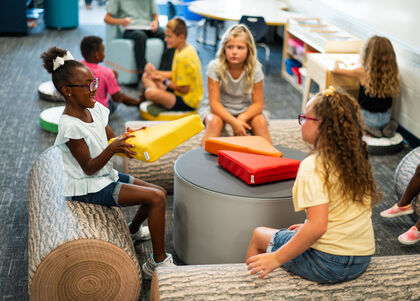Loading...

Rooted in Learning: The Power of Biophilic Design in Schools
As education evolves, schools are increasingly adopting biophilic design to create environments that support student well-being, creativity, and focus. But what exactly does biophilic design mean, and why is it becoming so influential in today’s classrooms?
Understanding Biophilic Design
Biophilic design involves integrating natural elements into indoor spaces to foster a connection with the outdoors. It is based on the idea that humans have an inherent need to connect with nature, and doing so can positively impact both physical and mental health. In schools, biophilic design means incorporating natural materials, lighting, and even outdoor learning areas to create a more balanced and calming atmosphere for students.
What Does Biophilic Design Look Like in Schools?
Biophilic design in educational spaces can take many forms, and there is no one-size-fits-all approach. Depending on the needs and possibilities of each school, this might include:
- Maximizing Natural Light: Incorporating large windows or skylights allows sunlight to flood classrooms, making them feel more open and uplifting.
- Adding Greenery: Whether it’s a few potted plants, hanging gardens, or even living walls, greenery can bring a sense of calm and improve air quality.
- Natural Materials: Using materials like wood, stone, or bamboo in furniture and finishes can create a more grounded, welcoming environment.
- Outdoor Learning Areas: Spaces like school gardens or outdoor classrooms offer students a direct connection to nature, turning learning into an immersive experience.
Nature-Inspired Textures: Carpets or seating that mimic natural textures, like grass or leaves, can make indoor spaces feel more in tune with the outdoors.
Take, for example, our NEW HemiSphere at Fōmcore that adds a playful touch of nature to classrooms. This sphere, designed to mimic the look and feel of grass, not only brings a natural element indoors but also offers a cozy spot for students to take a moment to themselves—whether to rest, read, or recharge.
While the examples above illustrate various ways to integrate biophilic elements, the approach needs to be tailored to each school’s specific needs and layout.

For some, rearranging furniture to maximize natural light or adding a few plants may make a big difference. For others, larger projects like developing an outdoor learning space or installing green walls could have a transformative effect. The key is to thoughtfully design each space with students' needs in mind.
The Research Behind Biophilic Design
Evidence suggests that biophilic design can have a significant positive impact on students' well-being and learning outcomes:
- A study from the University of Illinois discovered that students with access to views of nature from their classrooms showed improved focus and higher test scores compared to those without such views.
- The “Biophilic Design and Learning” report by Terrapin Bright Green highlights that exposure to natural elements can lower stress levels, creating a more relaxed atmosphere that is conducive to learning.
- Research from the University of Salford found that classrooms designed with natural light, better air quality, and organic materials can increase students' learning rates by up to 16%.
- By incorporating nature into learning environments, schools can create spaces where students feel more at ease, allowing them to focus better and absorb information more effectively.

Why Biophilic Design Matters
Biophilic design is more than just a trend; it’s a strategy for creating spaces that nurture the whole student. As schools work to address challenges around student well-being and engagement, incorporating elements of nature offers a practical and effective way to support students' needs. By designing classrooms that connect students with the natural world, we’re creating places where they don’t just study—they thrive.
References:
University of Illinois. (n.d.). The Impact of Views of Nature on Student Performance.
Terrapin Bright Green. (n.d.). Biophilic Design and Learning: Reducing Stress and Enhancing Well-being in Schools.
University of Salford. (n.d.). Classroom Design and Its Impact on Learning Rates.
Human Spaces. (n.d.). How Biophilic Design Improves Student Well-being.
Association for Supervision and Curriculum Development. (n.d.). Creating Learning Environments That Embrace Nature.